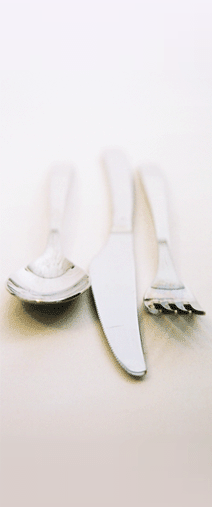Lost in Translation Five
November 23, 2005
21:49 PM
Strange how similar words in different languages are not always as alike as they appear,or how the simplest direct translation from English into French is not always successful.
Take the classic example of the Irish Au Pair refusing second helpings by saying “Je suis Plein” and finding it difficult to understand the consternation ensuing from this.
Her simple “I’m full” had turned into “I’m Pregnant” in translation.
Many years ago, while swimming in Brittany, a child close to me started to call for her Father, Papa started to bound through the waves to her shouting (perfectly correctly)“J’arrive , J’arrive”
To me that sounded as if he saw himself as an aeroplane or –if human- the Queen of Sheba, the only person I know of who “Arrives” instead of coming.
Walk into any busy French restaurant and they will say “Installez Vous”.
This always makes me feel that they think I am a central heating system.
This, of course is all leading us somewhere.
Our friend Claire Corcoran, who was with us over the weekend gave me a present of a book which she had bought recently on a visit to Paris.
This is a dictionary of French cookery; “The A-Z of French Food” which is published by Scribo.
For a Chef with lexicographical tendencies it is a dream present and having just finished reading it (sad but true, I read dictionaries for pleasure) I am determined to share some of my gleanings with you.
To revert to the topic of words which although they sound alike are quite different in meanings, cookery terms are a particular minefield.
Let me give you a few examples;
Lard in French, is our bacon, our lard they call saintdoux but, should you come across some particularly lean bacon, the French word for this is… you have guessed it: Bacon.
What they call Marmelade is not our Marmalade. It is a conserve of any fruit or even vegetable, as in Marmelade De Pommes, or Des Ognions.
The French word Apron is a river fish, that which protects our clothes in the kitchen, and without which I cannot cook, is a Tablier.
My friend Jean Augier from the village of Rasteau in Provence told me that he hunted for Truffles with a Baguette. I am relieved to learn that as well as being our familiar French loaf a baguette is also a simple wand or stick, and that Jean was not wandering through the oak woods of the Vaucluse waving a loaf of bread.
When we make a particularly rich and creamy cake we tend to upgrade it by calling it a “Gateau”. In the same way when the French housewife makes a rather plainer cake, one which we would call a “Tea Bread” they, of course call it “Le Cake”.
On the same lines they have a marvellous term for an overindulgent Father, one that rings a particular bell with a chef/father of three daughters ; a Papa Gateau.
You know that a Papa Gateau would look like, he would be developing a paunch, or as the French say, prendre de la brioche , from the distinctive protuberance on top of that particular buttery loaf.
On the subject of butter, one who does “after hours” work to provide for those little extras we love so much, is, in Ireland, said to be “doing a nixer”
In France it is called to “Mettre du Beurere dans les epinards” or buttering the spinach.
This is so French, you can of course eat spinach without butter but, it is worth working longer hours not to have to!
Still on the subject of butter ,we have thousands of euphemisms for drunkenness in our culture, among them is being “ well oiled” but I do think the French “se beurrer” is more elegant.
Although not strictly a culinary word,(but what is a meal without wine?) I think their adoption of bouchon or cork for a traffic jam is particularly apt.
Many is the hot summer when, stuck in a bouchon on the auto route, I have wished for a Giant Sommelier God to arrive with his Tire Bouchon and release us.
Another French expression which relates to their great joy of eating is to be “ Entre la Poire et le Fromage”, that is; to be elated.
Having run a restaurant for many years , I have always noted that people are at their most beneficent just after a good meal, or as the French say at that moment between the dessert (la poire) and the cheese(le fromage.)
(Interestingly this is a fairly good indication that the French also originally ate their dessert before their cheese.)
Their particular euphemism for domestic strife is “Le torchon Brule”or burnt tea towel, it is hard to tell why this is , maybe it is the burning of the tea towel which causes the friction? It would in our house!
That they don’t much like the turnip in France is evident, I think in their expression for a flop (as in a bad play or book) which they call a “Navet”.
This is nothing whatever to do with the pig French phrase with which we used to translate the Dublin expression “A queer turn up for the books” as “ Un Navet bizarre pour les livres”.
The French when embarrassed don’t of course become as red as a beetroot but, “Rouge comme un homard”, they don’t , likewise, take French leave but filer a l’Anglais, and my beloved Jacques Brel uses a wonderful expression for “a sound man” when in the song, Le Moribond he describes his friend Emil as “Bon comme de pain blanc”- what after all is “sounder” than a loaf of white bread?.
My favourite French culinary term , brings me right back to my days in Snaffles when my mentor Rosie Tinne taught me how to joint my first chicken and showed me the chickens “oyster” , that succulent morsel tucked in underneath the thigh joint on its back.
That piece of the chicken, Rosie explained to me, was the only part Henry the Eighth would eat, all the rest was discarded.
An image that seemed incomparable to me.
Incomparable that is until I came across the French term for that same morsel.
They call it “Sot-l’y-laisse or, to roughly translate “(that part which only)a fool would leave”
Touche !
Absinthe Glasses
November 22, 2005
01:57 AM
This is my hundredth blog, or “words” piece as I chose to call it on February 26th last when I was started off by my long suffering daughter/computer engineer/mentor; Caitriona.
Getting my first digital camera a couple of months later has of course added another dimension to the words, but hell, “words and pictures” aint going to fit into the little clicking place on top of my web page so words it will have to remain.
To celebrate the hundredth (no great deal I know when compared to Caitriona recently passing 500 ) I decided to show a little of one of my great passions which I have previously only referred to
En Passant; my glass collection.
My friend Clive Nunn was always interested in old glass and I guess that is what started me looking at it.
He had a good collection of old Rummers which I made spectacular efforts to break my way through while having enjoyed their contents a little too much while Chez Nunn
In the summer of 1989 we went on holiday with my brother and sister in law, Una and Martin and rented a gite near Les Eyzies de Tayac in the Dordogne.
In an old Armoire in the dining room there I found some glasses with which I instantly fell in love.
This is an affaire which has lasted through faithfully to today, 16 years later.
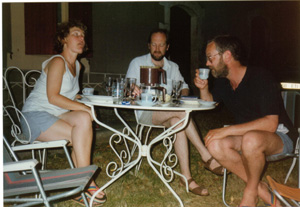
Martin, Una and I dining Al Fresco in the Dordogne
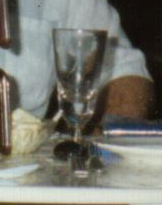
A close up of what we were drinking out of.
It took all of Sile’s integrity to persuade me not to rob some of these to take back to Ireland.
However the following year, while we were on holiday, this time in the Cote d’Azur, I found my very own , similar glasses at a Foire de Brocante in Fayence.
This was the start of a collecting mania which, at times , has resembled an addiction.

The Fayence Glass.
At the time I remember being a little peeved that someone had gouged a line in on the bowl of the glass.
It took a chance encounter with a painting by Manet before I realised that I had now become a collector of Absinthe Glasses.
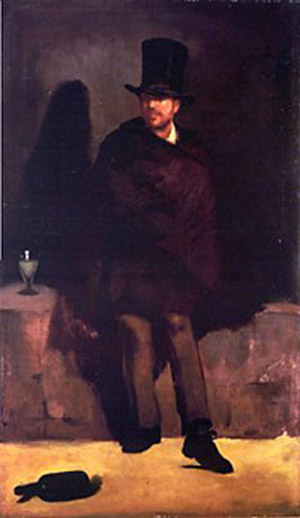
Manet’s Absinthe Drinker
There it was my exact glass!
This was a very exciting moment.
The line in the glass of course was merely to indicate the level to which the spirit should be poured.
Even more exciting was coming across a mysterious painting by the Swiss artist Ihly.
This showed the very same glass, cracked and badly chipped, but still full of Absinthe, used by what we would now call a “Wino”.
It is mysterious because no-one has ever been able to make out what it is in his mouth.
(As a total aside I was once asked, by e mail, where this picture hung. The request came from a Swiss doctor who wanted to use it as an illustration in a book he was writing on Alcoholism and he wanted to get permission from the museum.
The bizarre truth, which I was able to tell him was that it was hung in the museum of his home town in Switzerland)
This painting was likely intended to be a lesson on the evils of drinking, what was shortly to become a prohibited drink; Absinthe.
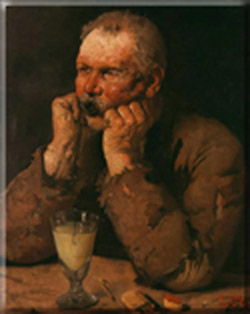
Ihly’s Absinthe Drinker
I was now away on a hack and nothing was ever going to stop my headlong acquisition of these glasses.
The Absinthe Glass of France was just the pub glass of its day.
Very sturdy (just as well considering my previous attempts to decimate Clive’s Rummers) they came in all shapes and sizes made for everything from beer to liqueurs.
I collected them all.
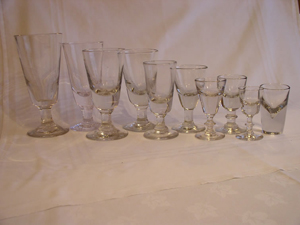
Having a restaurant gave me the ultimate excuse as I decorated all the walls with shelves full of glasses. I persuaded the same Clive Nunn to redesign the dining room of the restaurant to give me even more space to display my treasures.
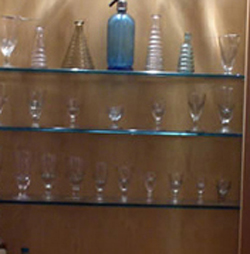
One of the Restaurant Glass display Dressers
In the fullness of time I was asked by Mary Boydell, the doyenne of Irish Glass, to address the glass society of Ireland on my collection of Absinthe Glasses.
One of the great thrills of my life!
One of the advantages of that particular moment was that to prepare a Powerpoint presentation for that lecture I managed to persuade Caitriona to photograph lots of my glasses.
Now, with most of them in storage,I at least have something to oogle, and some pictures with which to illustrate this piece.
Of course the passion very quickly spread byond the confines of Absinthe Glasses and very soon I was collecting glass from different places and with many different uses.
Among my favourites are these Toastmasters Glasses
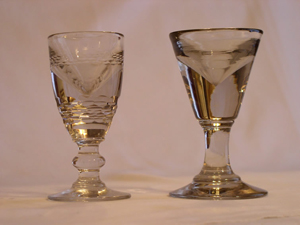
Which were made deceptively shallow to avoid the utter inebriation of the man calling for “Health”
But then Mary Boydell says they could also be “Penny Licks” which were the precurser of the Ice Cream cone.
Whichever they are I love them dearly and, you have been warned, this 100th blog will be the first of many about my collection of glasses.
Now I think we should raise our glasses for a toast to the first 100!
1 comment.
Woodstock
November 21, 2005
13:50 PM
By the time we got to Woodstock we were half a million strong,
And every where we looked there was a song and a story.
That was written by Joni Mitchell around 40 years ago,
this version happened last Sunday.
For “half a million strong” read “half a dozen strong”
But as for the “song and the story”….
Six old friends, all particularly well endowed with
the gift of tongues, who have met very little for the
last thirty years (being busy conceiving, having,
and rearing our children)
did not , I promise,
leave many lapses in song or story.
Robert, Ann, Dave and Claire, old college friends, came to dinner with us on Saturday.
Well fed, and very relaxed we decided to go and visit Woodstock Demesne on Sunday.
It was at its best.
Wonderful Autumnal Colours

There is a restoration project going on
to restore the formal gardens.
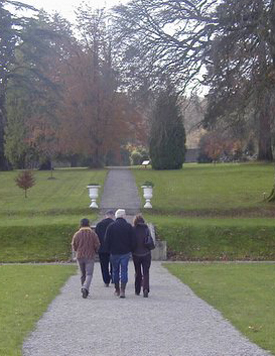
But we were greatful to see that the animals
still remain firmly behind bars.

Woodstock has a marvellous supply of rare
exotic trees.It was great to see that the
Hayesmacoyus was showing some early buds.

But Robert, who took these photos was concerned
at the evidence of strong leaf fall , surely
rare at this time of year?
A sign of Global Warming?
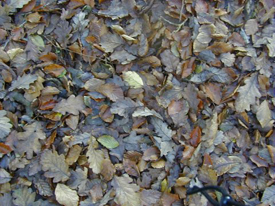
We left puzzling at the nature of this avenue.
Why were the trees so mysterious to us?
Was there some primal link?*
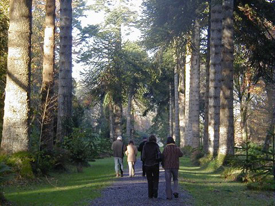
*They are in fact Araucaria araucaria
and the dictionary will solve the puzzle.
Thanks to Robert Hayes McCoy for the photos,
(except the one of the Hayesmacoyus which I took)
Seed and Nut Bread
November 17, 2005
00:30 AM
One of the resolutions I made when I sold the restaurant and we started our new life was that I would make all of our bread.
So far so good.
I think we have bought about six loaves in total since then.
I have been alternating between the Bennetsbridge Brown Loaf and the Sundried Tomato
Today I decided it was time for a change and I made my first batch of this Seed and Nut Bread.
I modestly declare it to be delicious.
I love the crunchy texture the various seeds make.
I can see this one is going to become part of the repetoire.
I think it is easier to make four of these at a time as it freezes beautifully and, if we are not too profligate, four loaves lasts us for about a week.
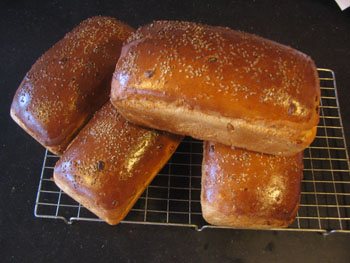
Seed and Nut Bread
Recipe for 4 x 900g (2lb.) loaves
1.8kg (4lbs.) Strong White Flour
2 X 7g Sachets Fast Action Yeast
1 teaspoon Salt
6 Tablespoons Olive Oil
110g (4 oz.) Sunflower seeds
60g (2 oz.) Pine Nuts
60g (2 oz.) Pinhead Oatmeal
60g (2 oz.) Sesame Seeds
1.2 litres(40 oz.) Warm Water
1 Egg
Heat a little olive oil in a non-stick pan.
Toss in the sunflower seeds,pine nuts, oatmeal and sesame seeds.
Stir these on a med heat until they go golden brown .
Take off the heat and let them cool.
Put the flour,yeast, and salt in a large bowl.
Pour in the olive oil.
Add the warm water to the bowl and blend all the ingredients together with your hands.
Add in the toasted nuts and grains and mix these into the dough.
Knead the mixture in the bowl until the bowl comes fairly clean then put it out on a lightly floured counter.
Now you want to knead it for at least 5 mts.
As you knead the dough will get noticeably smoother and less sticky.
Oil your four tins well and, if they are not well seasoned (or Non-stick) it is a good idea to line the bottom with some tinfoil or greaseproof paper.
Divide the dough between the tins.
Put these in a warm place for at least an hour (if not warm enough they can take a lot longer,
I sometimes light the oven to its lowest and put them in the grill space over the oven)
They should rise over the tops of the tins .
Pre Heat the oven to Gas 6, 200C, 400F.
Just before you put these in the oven, paint the tops with some egg wash and sprinkle over some more sesame seeds.
Cook the loaves at this temperature for 30 mts.
Shake them out of their tins and put them back for another 10 mts to crisp the base and sides.
Let them cool before eating or freezing
Dornford Yates, My Comfort Read.
November 15, 2005
10:43 AM

An original cover from 1921
I have never made any secret of the fact that my idea of comfort eating is mashed potatoes, a dish high in carbohydrates and fat.
Now at my advanced years I think I have to come out of the closet about my idea of a comfort read and introduce you to Dornford Yates.
Like mashed potato, in dietary terms, Yates has his faults, he is racist, misogynistic, class obsessed, jingoistic, and often writes prose of a tone so purple that one would be forced to call it puce.
Orwell called him the direct precursor of Fleming and his James Bond novels,(and he was not intending to flatter by that) he has also been credited with inspiring Enid Blyton and her adventure stories for children (now much discredited).
Yes I admit he is all of these things, but , if I want a moment of literary escapism having had my bellyfull of attempts to read uplifting works of literary merit, I go back and read and reread my Yates.
He was born in the 1880s and wrote best sellers during the first 50 years of the twentieth century.
He is most famous for his “Berry” series which could be called comedies of manners set in 1920s upper class, home county England and his “Chandos” novels which are straight thrillers with none of the sophistication of modern works but set at a time when the villain was a villain and possible either a Jew or a Hun.
But principally there is this wonderful British upperclass hero, Richard (who inexplicably is sometimes called William!) Chandos and his buddy Jonathan Mansell.
I have just finished re reading “Red in the Morning” a novel of this genre
first published in 1946.
In this, Gedge, the villain, dares to kidnap Chandos’ wife Jenny.
As he rescues her from Gedge’s clutches he says;
“You have laid hands on my wife, the punishment for that is death.”
Wonderful stuff that, and when Chandos eventually throttles Gedge and then goes back to talk to Mansel the conversation goes like this;
“Our gentleman friend ? (he said)
“Is dead”
“Damn you William,” said Mansel “I wanted to kill him myself”
With dialogue like that how can anyone fail to be seduced.
I first came across the Dornford Yates novels at home as there was a large selection of them in the bookcase in our drawing room.
As a voracious 12 and 13 year old reader , and this prior to the age of television, I devoured them whole.
This provides the necessary nostalgic suspension of critical thought from my analysis of Yates’ Oeuvre.
At that age his works were to me perfect expressions of chivalric nobility and all that I could ever want in terms of heroism and integrity.
As I did mature a little with the passing years I began to see that maybe he was not quite the liberated man I then aspired to, but now, in my middle age, and having totally forgotten all of the plots, he is perfect to return to.
If you want to give him a twirl I would recommend a duo of books. Anthony Lyveden, and its sequel, Valerie French.
These are probably his best works and I feel bear comparison with the atmosphere of mystery achieved by Alain Fournier in Le Grand Meulnes.
The best way to read them is with a patient spouse nearby who would appreciate the occasional guffaws as little vignettes of British chauvinism drop from Yates pen,and could stand being related same.
Despite all I still think he is a damned good read.
The Perfect Poached Egg
November 10, 2005
22:02 PM
I have been having a poached egg for breakfast now for the last 4 or 5 years.
As I already explained I wasn’t ever a great breakfast person when I was growing up but now it is one of my favourite moments of the day.
It does rather depend on the egg though.
As long as I have been poaching eggs for breakfast I have been using free range ones, and very much better than non-free-range they are.
But I do come from a background in which a very high standard for eggs was instituted;
We kept hens.
I presume that puts me in the same category as at least 50% of the country who can boast to my years.
God knows we didn’t realise what a privileged portion of the population we were.
I didn’t truly realise that I was now deprived, and had been for some time until I started to buy free range, organic and very fresh eggs in Waterford market during the last year.
The very first one I dropped into the water to poach remained, to my astonished eyes, oval.
I could actually see where the white ended and the water began before the white started to go opaque.
The yolk remained in the centre of the white and the white maintained, almost, its shape during the cooking.
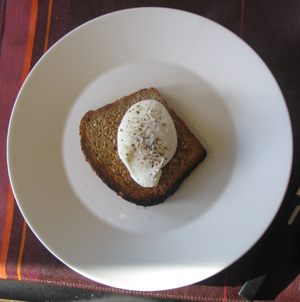
The taste…. Well Proust had his Madeline, I had my poached egg.
I was back in the family kitchen in Cork, and I could see the blue tiles on the kitchen floor.
So rule number one of the hunt for the perfect poached egg is;
First catch your Egg.
Next rule do put some vinegar in the water.
This helps all egg whites from disporting themselves gaily throughout the pot.
The pot ( or pan)is the next point.
If you are cooking one egg use a small shallow pan.
If you are cooking two or (at a pinch) three or (at a very hard pinch) four, use a large frying pan.
If you are cooking any more cook them in batches, leave the guests wait for them.
Fill the pan with about two inches of water only, add 1 Tablespoon of vinegar (I have found that cheap white malt is just as good as and considerably cheaper than white wine or cider vinegar and I buy some specifically for this purpose)
Do not add any salt.
Now bring the pan to a rolling boil.
Ignore those people who tell you to bring it to a mere susurration.
How you are going to tell this if you haven’t previously reached boiling point?
You risk putting the egg into barely warm water where even the freshest whites will have blended with the water by the time it boils, leaving you with a sad obscene and bald yolk and a large pan of frothy milk.
In this, you may gather, I speak from experience.
So bring the water to the boil, then reduce to a gentle but visible simmer.
Break the egg into a saucer, and then insinuate (no other word will quite suffice for the gentleness of this action) the egg into the simmering water.
The amount of time you leave it in there depends to some extent on the size of the egg but much more on personal preference.
I take mine out one minute after the water resumes a visible simmer, maybe just an extra ½ minute if the egg is a large one.
I like my poached egg with the white just set and the yolk liquid, dark yellow but hot.
One more action before you take it out of the water.
Put your slotted spoon into the water and gently flip over the egg, and lift it out upside down.
Now as you lift the egg out of the water all the water trapped in the folds and interstices of its top will flow happily pack into the pan where they should be and not onto your toast making it like a disagreeable piece of disintegrating porridge.
I presume that at this moment you will have a slice of hot, thick and crisp toast waiting for its egg, an essential, the only permitted alternative being a likewise crisp but soft in the middle potato cake.
Have ready a black pepper grinder which grinds coarsely and some Maldon Sea Salt.
Anoint the egg with both and enjoy it.
1 comment.
Ghost of Halloweens Past
November 10, 2005
09:17 AM
Kilmacleague
November 9, 2005
12:34 PM
Kilmacleague was the first house we actually owned.
Up to this we had been living, happily, in rented houses in various towns in Ireland , England and even France.
This was supposed to be the moment when we finally put down roots.
Of course it wasn’t what our peers were buying into, suburban and semi detached.
Nor was it a romantic old cottage with stone walls and a cottage garden.
Our house in Kilmacleague was a modern,, bungalow bliss, prefab which had been hurled into the middle of a 1 ½ acre site close to, but out of sight of the sea near Dunmore East in County Waterford.
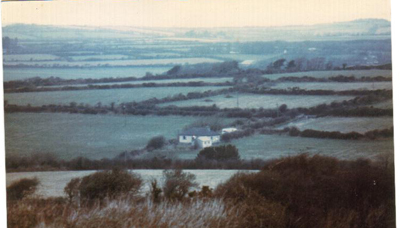
We moved in on Eileen’s second birthday, October the 30th 1981.
Caitriona was 5, and Deirdre was still 15 months away from being born .
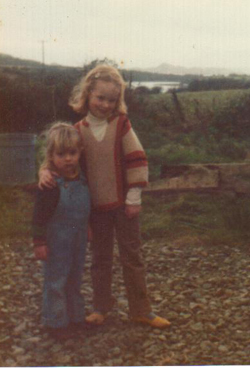
Note water in estuary in background. This meant the tide was in.
Mrs. Ashley, the old woman who sold it to us had moved back to England but had asked us to her going away party before she went- “To meet the neighbours”. A good omen. And the good will lasted .
We were to be extremely happy there.
At that stage I was working in Ballinakill House, a small country house restaurant in Waterford, Sile was in Scoil Lorcain, a primary school also in the town where she still teaches.
Buying a house put us financially at the very brink of disaster.
A larger than normal milk bill was enough to push us close to bankruptcy, and if the calor gas ran out of the cooker at an inopportune time of the month we just shifted cooking the tea out into the garden and continued the operation on a fire of twigs. There was no fear of what the neighbours might think of our conduct, we were surrounded by green fields peopled only by cows and the odd fox.
True we couldn’t see the sea, just a brief glimpse of the estuary when the tide was in, but we could hear it booming gently on the nearby back strand and at night the sky was lit by the regular flashing beams from the lighthouse in Dunmore.
The children loved the country from the beginning.
They were a solitary pair anyway. Not particularly gregarious (unlike daughter number three) they enjoyed their own company and wandering through the fields, making potions from wild flowers, and houses under thorn trees.
The house had its problems, every summer our well ran dry and we had long dry periods of being careful not to flush the loo and borrowing baths from friends.
Not having any money meant that we couldn’t afford booze.
This we remedied by concocting various country wines and beers.
I remember that the Blackberry Wine was successful, I also remember the phenomenal hangovers which the Rose Hip gave us.
We made various attempts to conquer the “garden”.
The truth of the matter was that it needed some heavy machinery to tame it, this would have been way beyond our means. We did plant little bits here and there and on occasions would find traces of the old gardens the Ashleys had planted years ago.If you beat your way through the brambles you could sometimes find raspberry canes and blackcurrant bushes still bearing fruit.
Our neighbours were wonderful, kind helpful and generous.
We were never lonely there, even though it was very isolated.
I suppose the main nostalgia for Kilmacleague is that it was there our girls spent most of their childhood.
It is amazing now to remember the days when all three were bathed together

(Sorry Girls)
Or when they went of “Tricking or Treating” to our (few and far between) neighbours.

(Deirdre’s costume was a jumper of Sile’s, Caitriona’s school tights and a “Free a Nipper” on her head. She was convinced that she was indistinguishable from a wolf and anxious that she might be too scary for the neighbours)
Even though we never managed to make much of an impression on the garden its very space was a marvellous luxury.
Loads of room for a swing

Or for the two older ones to learn to ride bikes.
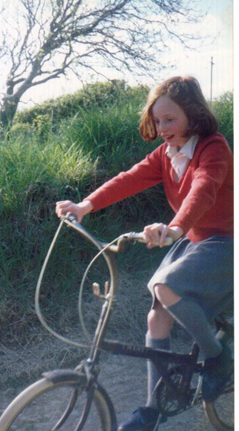 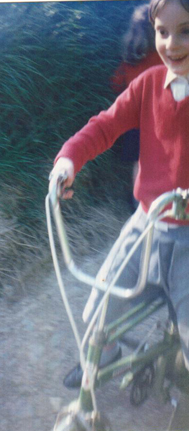
Even the adults managed to enjoy themselves
in a ceidhleidh in the kitchen for my 40th in 1989
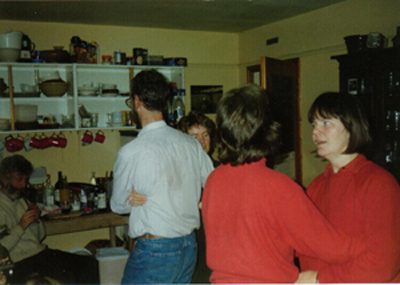
With Sile’s sisters Maire and Una and brother-in-law Padraic on the feadog.
But in late 1989 the prospect of a Restaurant in town raised its head so we decided to pack up and go. It was just getting to the stage that the girls social life was being hampered by living 7 miles out of the town without any public transport. (Except for the Saturday morning bus) and Sile and I were getting rightly sick of being a taxi service.
Sad to go but a perfect house to have a childhood in.
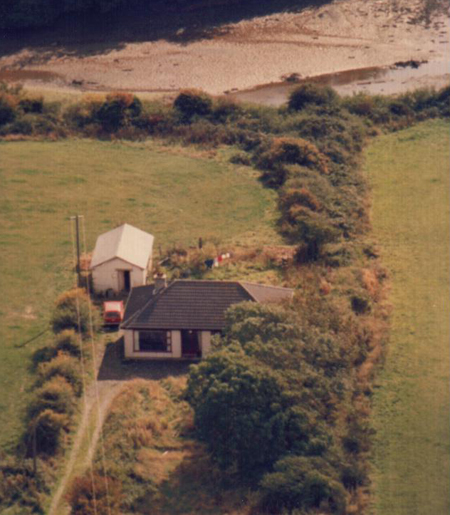
The ubiquitous Ariel View
We often go back for a sentimental wallow.
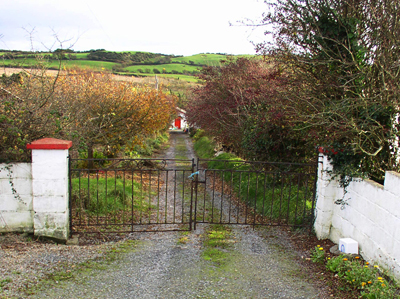
Caitriona took this picture of the gate earlier this year
1 comment.
Butlers Green Tomato Pickle.
November 8, 2005
10:42 AM
Any close follower of this piece will be aware that this is the winter of the green tomato.
I started off with my glut, got my fortuitous present of apples and thus was born
Joe Moore’s Chutney.
The first batch was so good that I went looking for more green tomatoes and my kindly veg man at Waterford Market agreed to barter some with me for some of the finished chutney.
These I shared out with Petra and Donal (Donal being Joe Moore’s son)
and made the rest up into more “Joe Moore’s” .
I now have (even after donating several pounds to friends) a fairly healthy 10 kilos of the same, enough to get me over the year and provide quite a few Christmas presents.
On Saturday, son-in law Aonghus Butler arrived in Waterford
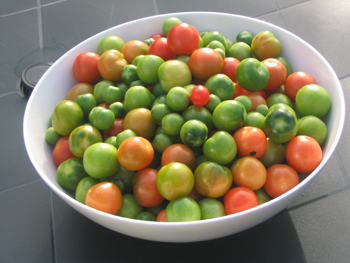
with another 3 kilos of green tomatoes,
grown on their balcony in Dun Laoghaire.
Time for a new recipe.
A quick Googling of “Green Tomatoes” reveals a world of recipes.
Apparently in a lot of countries the green tomato because of it’s firm tartness is preferred to the red, particularly for cooking. (The Americans have even called a film “Fried Green Tomatoes” after a café which specialised in same.)
As well as frying there are myriad recipes for chutneys, relishes, jams and
pickles.
Pickled Green Tomatoes rang a bell.
I had memories of trying a Green Tomato Pickle from the great Constance Spry many years ago after a similar glut.
This called for leaving the tomatoes whole and was exceedingly sweet. The resulting pickle looked marvellous, like one of those Italian “Mostarda di Cremona”, but as well as being too sweet, the tomatoes were too “cotton woolly” and, having decorated our dresser for a couple of years it was thrown out.
When I went back to look at her recipe I did however notice that, in her introduction to it, she said “this Danish recipe”
Could it be that she had just gotten the recipe wrong?
It called for 4 pounds of tomatoes to 4 pounds of sugar to a mere half litre of vinegar.(Yes she gave pounds and litres in the same recipe )
Back to Google, but this time looking for Danish Green Tomato Pickle.
There in
http://members.shaw.ca/jliebgott/index.html
I found the following:
Grønne tomater
Green tomatoes
Wash tomatoes and split them in half. sprinkle generously with salt.
Let stand for twenty-four hours. Remove tomatoes and dry in a linen
cloth. For each kg. tomatoes, use 1/2 litre vinegar, 1/2 kg granulated sugar
and a bit of vanilla. Bring vinegar, sugar and vanilla to a boil. add tomatoes
and continue to boil for five minutes. Pour into crocks, cover with wax paper
and tie closed with a string.
This was much better.
The preliminary salting would get rid of a lot of the water from the tomatoes and leave one with a much crisper bite, and the sugar was effectively reduced by a half and the vinegar amount doubled.
Having previously tried it flavoured with vanilla, and not been too impressed, I decided to try an American variation I came across which called for the addition of onion and dill.
First thing I did was to halve and salt the green tomatoes.
Give them a quick rinse first then halve them, put into a china or glass bowl, sprinkle each layer with a couple of tablespoons of salt (purists only use sea salt), for my 2.6 kilos of tomatoes I used about 8 tablespoons.
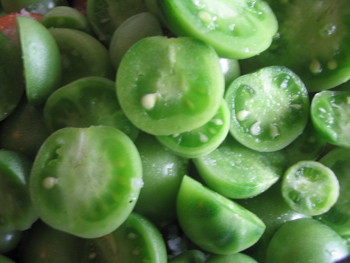
Now leave for 24 hours.
The following day drain off the water from the tomatoes, the salt will have drawn out a surprising amount.
My original 2.6 kilos was reduced to 1.8 kilos after draining( or roughly by a third)
I then gave these a rough patting with a tea towel to remove any loose water and weighed them again.
Then for every kilo of green tomatoes I weighed half their weight in onions, half their weight in caster sugar and the same in capacity of white malt vinegar ( or you could use white wine or cider vinegar)
My recipe ended up looking like this:
(I decided to call this one after the Son-in- Law who had provided the tomatoes)
Butlers Green Tomato Pickle.
2.60 kilos Green Tomatoes (1.8 kilos after salting)
4 Tablespoons Salt
900 g Onions
900g Caster Sugar
900 ml White Malt Vinegar
4 heads of Dill (or 4 teaspoons of dried Dill)
1 Chilli finely Chopped
Halve the Tomatoes, sprinkle between layers with the salt and leave for 24 hours. Drain, then pat these dry with a cloth and weigh.
Peel and finely slice the onions.
Put the vinegar, sugar and dill in a large pot and bring to the boil.
Simmer together until the sugar is completely dissolved.
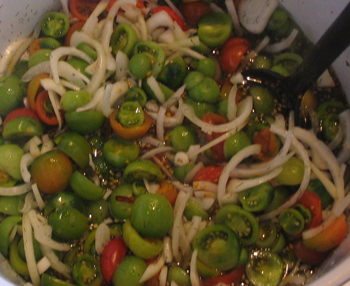
Add in the tomatoes, the onions and the chilli
and bring back to the boil.
Boil for 10 to 15 mts or until the tomatoes are soft
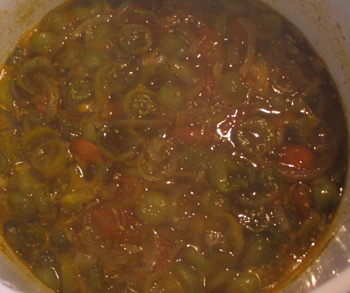
but still holding their shape.
Cool and pot as for jam.
One small tip I discovered is that a great way to make sure your jam jars are sterile is to give them a wash in the dish washer. This saves an awful amount of fiddling about with boiling water.
The final result is quite delicious. Sharper and crisper than the chutney and interestingly reminiscent of ( but much better than!) the Dill Pickle they use in Mc Donald’s!
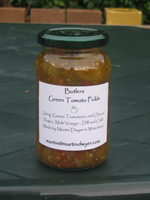 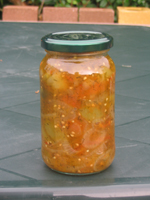
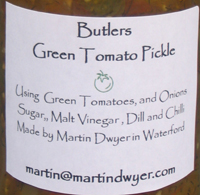
The finished product.
1 comment.
No Crock of Gold
November 6, 2005
00:19 AM



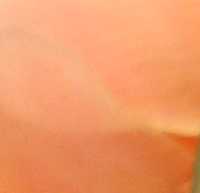
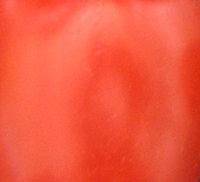


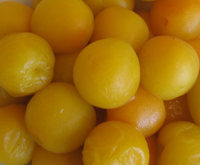






Siobhan’s Pink Rose,
Bridesmaids bouquet,
Siobhan’s Other Pink Rose,
Carbally Church Wall,
My Tomato,
Caitriona’s T Shirt,
Sile’s Rose,
Mirabelle Plums,
Ballyduff Field,
Ahenny Graveyard Upsidedown,
Jims Belly,
Sky over Waterford,
Bunmahon Rock
and Brides Bouquet.
|
